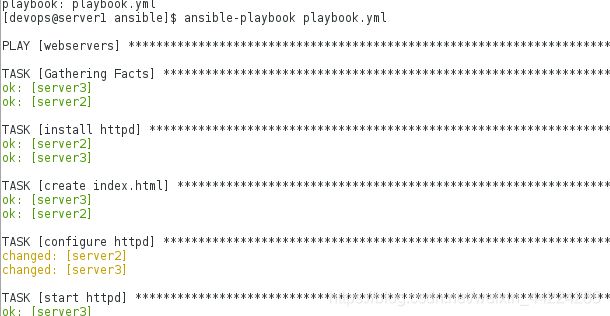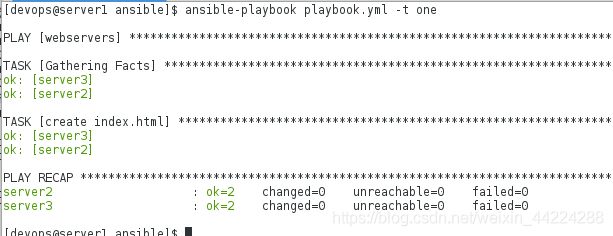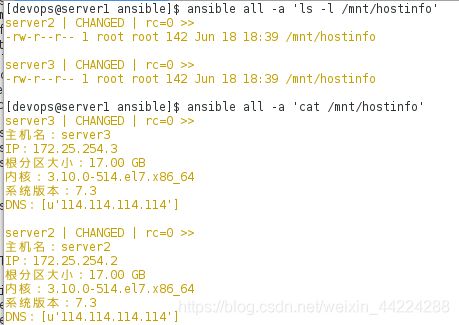企业—ansible的playbook应用
一.为什么要引入playbook
我们完成一个任务,例如安装部署一个httpd服务,我们需要多个模块(一个模块也可以称之为task)提供的功能来完成。而playbook就是组织多个task的容器,它的实质就是一个文件,有着特定的组织格式,它采用的语法格式是YAML(Yet Another Markup Language)。YAML语法能够简单的表示散列表,字典等数据结构。
二.yuml基本语法
1.列表:每一个列表成员都要有一个短横线和空格
fruits:
- Apple
- Orange
- Strawberry
- Mango
或者:
fruits: ['Apple', 'Orange', 'Strawberry', 'Mango']
2.字典:每一个成员由键值对组成,注意冒号后面要有空格
martin:
name: Martin D'vloper
job: Developer
skill: Elite
或者
martin: {name: Martin D'vloper, job: Developer, skill: Elite}
列表和字典可以混用
3.yaml文件中短杠和冒号后面默认为2个空格,配置本地用户在yaml配置文件中使用tab自动补齐2个空格
[devops@server1 ~]$ vim .vimrc
autocmd filetype yaml setlocal ai ts=2 sw=2 et
三.playbook的基础组件
- Hosts:运行执行任务(task)的目标主机
- remote_user:在远程主机上执行任务的用户
- tasks:任务列表
- handlers:任务,与tasks不同的是只有在接受到通知时才会被触发
- templates:使用模板语言的文本文件,使用jinja2语法。
- variables:变量,变量替换{ { variable_name }}
整个playbook是以task为中心,表明要执行的任务。hosts和remote_user表明在哪些远程主机以何种身份执行。其他组件让其能够更加灵活。
四.playbook的应用
部署httpd服务:
1.编辑yaml文件
[devops@server1 ansible]$ vim playbook.yml
文件编辑内容如下:
--- 必须有的
#deploy apache 操作说明
- hosts: webservers 定义主机
tasks: 任务
- name: install httpd 任务起名可任意
yum: 任务调用的模块
name: httpd
state: latest 安装最新版的
- name: create index.html
copy:
content: "www.westos.org\n"
dest: /var/www/html/index.html
- name: configure httpd
copy:
src: files/httpd.conf 需要在当前目录下建立files目录并且将httpd.conf文件放入该目录
dest: /etc/httpd/conf/httpd.conf
owner: root
group: root
mode: 644
notify: restart httpd
- name: start httpd
service:
name: httpd
state: started
enabled: true
- name: start firewalld
service:
name: firewalld
state: started
enabled: true
- name: configure firewalld
firewalld:
service: http
state: enabled
permanent: yes
immediate: yes
handlers:
- name: restart httpd
service:
name: httpd
state: restarted
files目录下的httpd.conf文件的添加:



2.检查yaml文件的语法错误并playbook该文件
[devops@server1 ansible]$ ansible-playbook playbook.yml --syntax-check 检查语法
[devops@server1 ansible]$ ansible-playbook playbook.yml --list-hosts 列出文件中的操作主机
[devops@server1 ansible]$ ansible-playbook playbook.yml --list-tasks 列出文件中的任务
[devops@server1 ansible]$ ansible-playbook playbook.yml

变量:
1.重新修改playbook.yaml文件,需要修改的内容如下:
[devops@server1 ansible]$ vim playbook.yml
[devops@server1 ansible]$ pwd
/home/devops/ansible
[devops@server1 ansible]$ cd files/
[devops@server1 files]$ cp httpd.conf httpd.conf.j2
[devops@server1 files]$ vim httpd.conf.j2
文件编辑如下:
42 Listen {
{ http_port }}
[devops@server1 files]$ ansible-playbook playbook.yml #server2及其server3的端口变为指定的变量里面的监听端口

3.验证:
//server2及其server3上http监听端口为yaml文件中所指定的

//主机名及其ip抓取检测

//tag指定所要执行的

模版:
举例:主机名的详细解析
1.编写yaml文件
[devops@server1 ansible]$ vim hostinfo.yml
---
- hosts: all
tasks:
- name: create infofile
template:
src: templates/info.j2 //指定摸版存放路径
dest: /mnt/hostinfo
[devops@server1 ansible]$ mkdir templates
[devops@server1 ansible]$ cd tempaltes/
[devops@server1 tempaltes]$ vim info.j2
主机名:{
{ ansible_facts['hostname'] }}
IP:{
{ ansible_facts['default_ipv4']['address'] }}
根分区大小:{
{ ansible_facts['devices']['dm-0']['size'] }}
内核:{
{ ansible_facts['kernel'] }}
系统版本:{
{ ansible_facts['distribution_version'] }}
DNS:{
{ ansible_facts['dns']['nameservers'] }}
[devops@server1 ansible]$ ansible-playbook hostinfo.yml
[devops@server1 ansible]$ ansible all -a 'ls -l /mnt/hostinfo' ##查看
[devops@server1 ansible]$ ansible all -a 'cat /mnt/hostinfo' ##查看内容
1.编写yaml文件添加判断
[devops@server1 ansible]$ vim install.yml
---
- hosts: all
tasks:
- name: install httpd
yum:
name: "{
{ item }}" ##迭代简单列表
state: present
when: ansible_facts['hostname'] == 'server2' ##执行的时候server3会跳过
loop: ##与item共同使用
- httpd
- mariadb
- php
- php-mysql
- name: install mariadb
yum:
name: mariadb
state: present
when: ansible_facts['hostname'] == 'server3'
[devops@server1 ansible]$ ansible-playbook install.yml

节点的批量解析
item循环时是一个列表
作影射有多少台机器作多少台映射
1.创建模版
[devops@server1 ansible]$ cd templates/
[devops@server1 templates]$ vim hosts.j2
127.0.0.1 localhost localhost.localdomain localhost4 localhost4.localdomain4
::1 localhost localhost.localdomain localhost6 localhost6.localdomain6
{% for host in groups['webservers'] %}
{
{ hostvars[host]['ansible_facts']['eth0']['ipv4']['address'] }} {
{ hostvars[host]['ansible_facts']['hostname'] }}
{% endfor %}
[devops@server1 ansible]$ vim hostinfo.yml
---
- hosts: all
tasks:
- name: create infofile
template:
src: templates/info.j2
dest: /mnt/hostinfo
- name: create hosts
template:
src: templates/hosts.j2
dest: /etc/hosts
owner: root
group: root
mode: 644
1.在ansible的配置文件中添加角色的路径
[devops@server1 ansible]$ pwd
/home/devops/ansible
[devops@server1 ansible]$ vim ansible.cfg
[defaults]
inventory = inventory
roles_path = roles
[privilege_escalation]
become=True
become_method=sudo
become_user=root
become_ask_pass=False
[devops@server1 ansible]$ mkdir roles
[devops@server1 ansible]$ cd roles/
2.使用ansible-glaxy创建角色,并且使用tree查看


3.在apache目录下的各个角色文件中添加相应的内容
//配置yml文件
[devops@server1 apapche]$ cd tasks/
[devops@server1 tasks]$ pwd
/home/devops/ansible/roles/apapche/tasks
[devops@server1 tasks]$ cp ../../../playbook.yml main.yml
//添加模版
[devops@server1 apapche]$ cd templates/
[devops@server1 templates]$ cp ../../../files/httpd.conf .
[devops@server1 templates]$ mv httpd.conf httpd.conf.j2
//添加变量
---
# vars file for apapche
http_port: 80
//添加触发条件
[devops@server1 apapche]$ cd handlers/
[devops@server1 handlers]$ vim main.yml
---
# handlers file for apapche
- name: restart httpd
service:
name: httpd
state: restarted
3.在ansible的相应目录下编写apache.yml文件调用roles下的角色
[devops@server1 ansible]$ pwd
/home/devops/ansible
[devops@server1 ansible]$ vim apache.yml
---
- hosts: all
roles:
- apache
[devops@server1 ansible]$ ansible-playbook apache.yml --syntax-check
[devops@server1 ansible]$ ansible-playbook apache.yml
从网上直接下载roles模版,以nginx为例
保证虚拟机可以上网:
ansible-galaxy install geerlingguy.nginx










